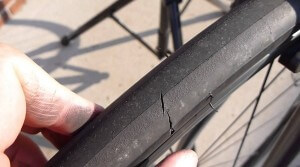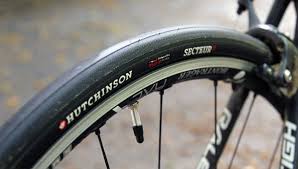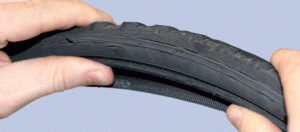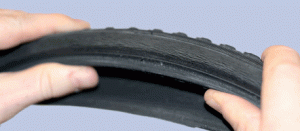 Riding a road bike is like flying — when you consider that your only contact with the ground is two, 1-inch patches. Commonly hitting speeds of 30-40 mph or more, bike tires are the most critical link to safety, and you bet your life on them. As lightweight and minimal as they are, they’re incredibly reliable if proper care is observed.
Riding a road bike is like flying — when you consider that your only contact with the ground is two, 1-inch patches. Commonly hitting speeds of 30-40 mph or more, bike tires are the most critical link to safety, and you bet your life on them. As lightweight and minimal as they are, they’re incredibly reliable if proper care is observed.

Average Mileage
Generally Speaking, expect 1000-2000 miles from the average road bike tire. Touring or puncture resistant tires often last 3,000 miles or more. High-performance racing tires, with their lightweight, minimalist design, may only last 1,000 miles.
Recommendations Only
Tire manufacture’s don’t typically state how long their tires will last, because they have no control over variables that effect the tires performance, primarily, how you treat the tire. The life expectancy of the tire is your responsibility.
Tread Wear
Tread wear on passenger vehicles can be determined at a glance, by an examination of the tread. Tread wear on bike tires is not relative in most instances, since most of them have little tread in the first place, which is typically replaced with a layer known as the contact patch. But there are other subtle indicators that your tire may or may not be worn out.

The Obvious
Obvious indicators are cuts, missing chunks and flat spots. Tires accumulate these randomly, depending on road conditions, and depending on how bad they are, are reason enough to replace the tire. The choice is up to the individual. Bulges or a tire that snakes back and forth when you spin it by hand is a dangerous tire. The snaking action is from separated threads inside the tire, and is a sure sign the tire will fail. Replace it as soon as possible.
The Carcass
If you can see the carcass thread — the criss-cross or diagonal pattern under the rubber, also known as the protection belt, the tire is well on it’s way to failure. Hopefully, you’ve changed it before it gets that bad. It’s not an imminent failure, but it’s best to err on the side of caution and replace it as soon as you can. If you don’t see carcass thread on the tread surface or contact patch, check the sidewall.

The Sidewall
The sidewall of the tire, or flank, is a better indicator of tire wear when the tread surface appears fine. The sidewall is thinner, and even if your tire isn’t that old, or doesn’t have that many miles on it, you might be seeing threads, or cracks if the tire has been neglected.
Neglect and Pressure
So you’ve calculated the miles, the contact patch and tread surface appears fine, but you’re still not out of the woods concerning life expectancy. Unfortunately, many tires do not reach their possible mileage because they are continually used with insufficient pressure. Premature tire wear occurs with prolonged use of the tire with insufficient pressure. When you run tires below their recommended pressure, the thin sidewall looses rigidity, and bends.
Used Bikes
Most serious cyclists don’t run faulty tires, but if you’re examining a used bike for example, you can look at a tire, and determine how it’s been treated by inspecting the cracks in the sidewall. Long cracks along the top of the tire mean that the tire has been run excessively with low pressure.

Evenly distributed cracks are not as serious. Age cracks mean that the tire has been taken care of, and may still have some miles in it. But seriously, if you can see cracks the tire should be replaced if you’re planning on doing any 30-40 mph downhill.

Check and Adjust
Check and adjust the inflation pressure each time you ride, — with a pressure gauge — to get the most out of your tires. Refer to the printed recommendations on the sidewall of the tire for the correct pressure or find your ideal tire pressure here.